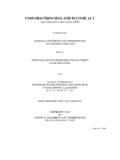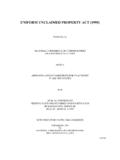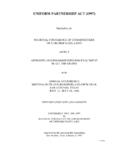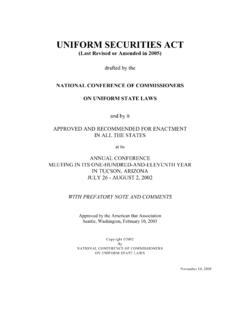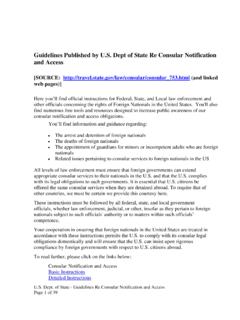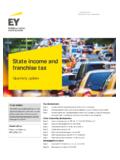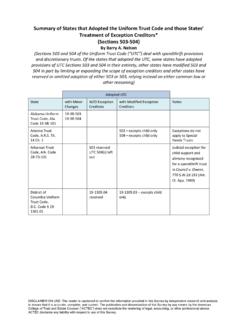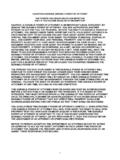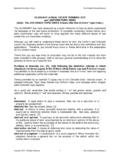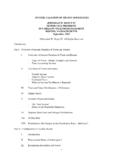Transcription of UNIFORM DIVISION OF INCOME FOR TAX …
1 UNIFORM DIVISION OF INCOME FOR TAX PURPOSES ACTD rafted by theNATIONAL CONFERENCE OF COMMISSIONERSON UNIFORM STATE LAWSand by itAPPROVED AND RECOMMENDED FOR ENACTMENTIN ALL THE STATESat itsANNUAL CONFERENCEMEETING IN ITS SIXTY-SIXTH YEARAT NEW YORK, NEW YORKJULY 8-13, 1957 WITH PREFATORY NOTEAPPROVED BY THE AMERICAN BAR ASSOCIATION AT ITS MEETING ATNEW YORK, NEW YORK, JULY 16, 1957 COMMENTS AMENDED 1966 The Committee which acted for the National Conference of Commissioners on UniformState Laws in preparing the UNIFORM DIVISION of INCOME for Tax Purposes Act was as follows:George V. Powell, 1111 Dexter Horton Bldg., Seattle 4, Wash., ChairmanGuy W. Botts, Barnett National Bank Bldg., Jacksonville, R. Bullivant, Pacific Bldg., Portland, H. Kuhns, First National Bank Bldg., Omaha 2, V. Morgan, District of Columbia Tax Court, 4 & E Sts., , Washington 1, Thormodsgard, University of North Dakota Law School, University, , Chairman,Section CCopies of all UNIFORM Acts and other printed matter issued by the Conference may beobtained from:NATIONAL CONFERENCE OF COMMISSIONERS ONUNIFORM STATE LAWS1155 East Sixtieth StreetChicago 37, Illinois-3- UNIFORM DIVISION OF INCOME FOR TAX PURPOSES ACTPREFATORY NOTEThe UNIFORM DIVISION of INCOME for Tax Purposes Act is designed for enactment in thosestates which levy taxes on or measured by net need for a UNIFORM method of DIVISION of INCOME for tax purposes among the severaltaxing jurisdictions has been recognized for many years and has long been recommended by theCouncil of State Governments.
2 There is no other practical means of assuring that a tax-payer isnot taxed on more than its net INCOME . At present, the several states have various forumlae fordetermining the amount of INCOME to be taxed, and the differences in the formulae produceinequitable results. The problem has been well analyzed and its historical background outlined inan article appearing in 18 Ohio State Law Journal, page UNIFORM DIVISION of INCOME for Tax Purposes Act is the result of conferences withthe representatives of the Controller s Institute of America, the Council of State Governmentsand various interested DIVISION OF INCOME FOR TAX FOR TAX PURPOSES ACTS ection 1. As used in this Act, unless the context otherwise requires:(a) Business INCOME means INCOME arising from transactions and activity in the regularcourse of the taxpayer s trade or business and includes INCOME from tangible and intangibleproperty if the acquisition, management, and disposition of the property constitute integral partsof the taxpayer s regular trade or business definition refers to the taxpayer s trade or business as if he had one business.
3 It isnot intended by this language to require a taxpayer having several businesses to use the sameallocation and apportionment methods for the businesses. The language permits separatetreatment of different businesses of a single taxpayer. Section 18 clearly permits from the disposition of property used in a trade or business of the taxpayer isincludible within the meaning of business INCOME .(b) Commercial domicile means the principal place from which the trade or business ofthe taxpayer is directed or phrase directed or managed is not intended to permit both the state where the boardof directors meets and the state where the company is managed to claim the commercialdomicile. The phrase directed or managed is intended as two words serving the same end; notas two separate concepts.(c) Compensation means wages, salaries, commissions and any other form ofremuneration paid to employees for personal definition is derived from the Model Unemployment Compensation Act which hasbeen adopted in all paid to employees becomes important in the payroll fraction in Section13.
4 If a corporation is employed to provide personal services, Section 18 may be used to include-5-compensation paid to corporations in the fraction if exclusion of compensation paid to corporateagents fails to reflect adequately the business activity in the state.(d) Financial organization means any bank, trust company, savings bank, [industrialbank, land bank, safe deposit company], private banker, savings and loan association, creditunion, [co-operative bank], investment company, or any type of insurance definition and the definition of public utility in Subsection (f) is necessary becauseSection 2 excludes from allocation and apportionment under this Act, INCOME from these twotypes of business activity. The exclusion is proposed because some states have separatelegislation for apportionment and allocation of INCOME of such taxpayers. If not, and the stateproposes to change Subsection (2) so as to apply the Act to such taxpayers, this would notnecessarily detract from the uniformity objective of this Act.
5 (e) Non-business INCOME means all INCOME other than business INCOME .(f) Public utility means [any business entity which owns or operates for public use anyplant, equipment, property, franchise, or license for the transmission of communications,transportation of goods or persons, or the production, storage, transmission, sale, delivery, orfurnishing of electricity, water, steam, oil, oil products or gas.]CommentIt is expected that public utility will be defined to include all taxpayers subject to thecontrol of the state s regulatory bodies on the theory that separate legislation will provide for theapportionment and allocation of the INCOME of such Comment to the definition of financial organization for purpose of this definition. Oil, oil products or gas is not intended to be so restrictive as to treat differently a public utility,if any, which transmits or produces gas products.
6 The essential point of the definition is therequirement that the business excluded by this definition and Subsection 2 be a public utility. Private transmission lines and private production or storage companies are thus not excluded.(g) Sales means all gross receipts of the taxpayer not allocated under Sections 4through 8 of this all inclusive definition of sales is intended to make apportionable all INCOME notallocated under Sections 4 though 8. As indicated in the Comment to Subsection (1)(a) incomefrom sales of property used in trade or business is included in apportionable INCOME .(h) State means any state of the United States, the District of Columbia, theCommonwealth of Puerto Rico, any territory or possession of the United States, and any foreigncountry or political subdivision 2. Any taxpayer having INCOME from business activity which is taxable bothwithin and without this state, other than activity as a financial organization or public utility or therendering of purely personal services by an individual, shall allocate and apportion his netincome as provided in this 3.
7 For purposes of allocation and apportionment of INCOME under this Act, ataxpayer is taxable in another state if (1) in that state he is subject to a net INCOME tax, a franchisetax measured by net INCOME , a franchise tax for the privilege of doing business, or a corporatestock tax, or (2) that state has jurisdiction to subject the taxpayer to a net INCOME tax regardlessof whether, in fact, the state does or does Section defines, for purposes of Section 2, where a taxpayer is taxable both withinand without this state. To bring this Act into operation a taxpayer must have INCOME frombusiness activity, and he must be taxable in this state, and also in some other tests are used by this Section to determine when a taxpayer is taxable in anotherstate. The first test is a fairly obvious one, the taxpayer is taxable in another state if he isactually subjected to the type of taxes listed in Subparagraph (1).
8 The second test, in Subparagraph (2) uses a notional or hypothetical standard ratherthan an actual one. Thus, if a corporation has its commercial domicile in state X, which has onlya sales tax and no tax measured by net INCOME , but that corporation has business activity in stateA, which has this apportionment Act, state A must apportion the business INCOME as provided inthis Act so that some of it is allocated to state X, even though as a result of the tax system of stateX a portion of the business INCOME escapes INCOME taxation. This is desirable in order to treatthe business of all states equally, and in order to avoid having this Act as a factor in inducing a-7-state to have an INCOME tax. If it does not wish to tax INCOME , that is no reason for a state whichdoes wish to tax INCOME to attempt to obtain more than its share of taxable should be noted that in Subsection (1)(h) the word state is defined broadly enough toinclude a foreign country.
9 This means that taxable in another state within Section 3 may meana foreign country. The apportioning state, however, need consider only whether the foreigncountry could have taxed the INCOME under the constitution of the United States if it had been Subparagraph (1) lists several types of taxes which might be actually in effect inanother state, the reference in Subparagraph (2) only to a net INCOME tax is not intended to bemore restricted in the hypothetical tax than the Section is with respect to an actual 4. Rents and royalties from real or tangible personal property, capital gains,interest, dividends, or patent or copyright royalties, to the extent that they constitute non-businessincome, shall be allocated as provided in sections 5 through 8 of this Section is the general Section on allocating nonbusiness INCOME to a state just asSection 9 is the general Section on apportionment of business INCOME .
10 Section 2 refers to anallocation and an apportionment of net INCOME . In allocating nonbusiness INCOME to a state,the states concerned with this allocation may desire to allocate the expenses properly attributableto nonbusiness but allocable INCOME in the same way that INCOME is allocated so that theseexpenses will not be involved in determining net INCOME from business activity whereapportionment is used. Section 18 of this Code empowers the state to make this adjustment if 5. (a) Net rents and royalties from real property located in this state are allocableto this state.(b) Net rents and royalties from tangible personal property are allocable to this state:(1) if and to the extent that the property is utilized in this state, or(2) in their entirety if the taxpayer s commercial domicile is in this state and thetaxpayer is not organized under the laws of or taxable in the state in which the property isutilized.
